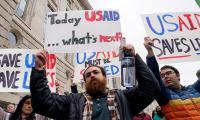After a flurry of praise for the police officer who saved her life, most Pakistanis seem to have forgotten the incident in Lahore involving the woman who was accused of blasphemy for wearing a dress with Arabic calligraphy. That a woman was almost lynched for wearing clothes that an illiterate crowd mistook for religious text highlights Pakistan’s extremism problem.
Dismissing events like this incident as outliers or choosing to ignore them will not prevent them from occurring again. In December 2021, the Sri Lankan manager of a factory in Sialkot was beaten to death and set ablaze by a mob over allegations of blasphemy that turned out to be spurious. The woman in Lahore with the dress bearing Arabic language words was lucky that she escaped a similar fate.
The dress worn by the woman in question bore the word ‘Halwa’ in Arabic script. The word means beautiful in Arabic, and it is not uncommon in the Muslim world for Arabic calligraphy to be used to adorn dresses, buildings, and much more. But the irrational environment in Pakistan over religious matters, especially allegations of blasphemy, put the woman’s life at risk. The international publicity over the incident ensured that everyone around the world who might be thinking of doing business with Pakistan had to think about facing similar risks.
Nations pay a hefty price when the rest of the world sees them as irrational or extreme. Racist violence, for example, acts as a disincentive for business travelers belonging to different races from traveling to countries where race is an issue. In the case of Pakistan, religious extremism and vigilantism have become a factor in the decisions of potential investors and merchants.
Two days after the Lahore incident, an Arab businessman remarked to me that he immediately thought of his wife and daughters. “They wear Arabic calligraphy designs as part of their dress,” he said, adding, “I was thinking of expanding my business to Pakistan, but do I want to walk through Lahore or Karachi with my wife or daughters, risking such attacks?”
Pakistan already has the world’s toughest blasphemy laws and blasphemy is punishable by death after a trial. But some groups do not wait for the law to take its course and want to act as judge, jury, and executioner. Several people have been lynched before their cases go to trial and those acquitted due to lack of evidence are also attacked as if the allegation of blasphemy requires no proof other than the allegation itself.
Judges, too, have to fear the backlash of those who pretend to be all-knowing while hearing such cases. Instead of making Pakistani society more religious or pious, the practice of whipping up a crowd in a religious frenzy has created situations in which mobs lose all fear of God. Even in the recent case of the woman wearing the Arabic calligraphy dress, the crowd had to be pacified with an apology from the woman though she had done nothing wrong. As Maulana Tahir Ashrafi pointed out, the men in the crowd, rather than the woman, should have been the ones to apologize.
Government after government in Pakistan has appeased groups that use religious slogans to divide and scare Pakistanis. Some have even seen the extremists as guarantors of Pakistan’s security or as instruments of Pakistani influence across the border in Afghanistan or Kashmir. But the net impact of nurturing a religious outrage industry has only been to undermine Pakistan’s external relations and weaken its economy. Official data suggests that between 2001 and 2018 “the direct and indirect cost incurred by Pakistan due to incidents of terrorism” amounted to $123.13 billion.
Add to it the cost of fostering a society driven by anger and unable to figure out its real place in the modern world. Since falling under Western colonial rule, the Muslim world has developed a narrative of grievance and Pakistan is no exception. Like all national and community narratives, it has some true elements. But the current weakness of the Muslim world or of Pakistan is not entirely the fault of Western colonialism or postcolonial machinations.
Pakistanis must understand the consequences of low literacy rates, poor quality of higher education, and low female participation in the workforce. Instead, they are fed narratives of conspiracy theories and hate against more powerful nations and a steady diet of religious-sounding rhetoric that is more political than religious.
On March 6, 1948, Pakistan’s first opposition leader, Huseyn Shaheed Suhrawardy (who later became prime minister for a short time) warned the country’s earliest leaders against building “a state which would be founded upon caucuses and coteries, a state which will be founded on sentiments, namely that of Islam in danger or of Pakistan in danger.”
According to Suhrawardy, “a state which will be held together by raising the bogey of attacks and which you keep together by keeping up a constant friction between yourself and your sister Dominion [India], that state will be full of alarms and excursions. You think that you will get away with it but in that state there will be no commerce, no business and no trade.”
Cautioning against attacks on non-Muslims in the immediate aftermath of partition, Suhrawardy said that such a course will only erode rule of law. “There will be lawlessness and those lawless elements that may be turned today against non-Muslims will be turned later on, once those fratricidal tendencies have been aroused, against the Muslim gentry and I want you to be warned in time,” he observed.
Today, those words seem prescient. Even now, a comprehensive strategy of pushing back extremism is the only way forward for a country that faces a multitude of challenges.
The writer, former ambassador of Pakistan to the US, is Diplomat-in-Residence at the Anwar Gargash Diplomatic Academy in Abu Dhabi and Senior Fellow at the Hudson Institute in Washington DC.
In meeting at CM House it was said that 16 million children aged five to sixteen years are enrolled across Sindh
Agriculture is backbone of Sindh’s economy, contributing significantly to Pakistan’s GDP
Availability of information about performance of public entities is restrictive despite clear provisions of law
For countries like Pakistan, where climate emergency is harsh reality, these words carry profound significance
Pakistan has seen many cases where state enforced moral policing under air of sheltering social values
Is world ready for such technology to take over and gratify our need for connection in coming times?







